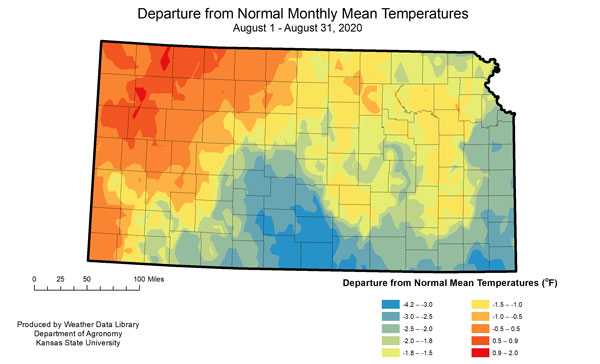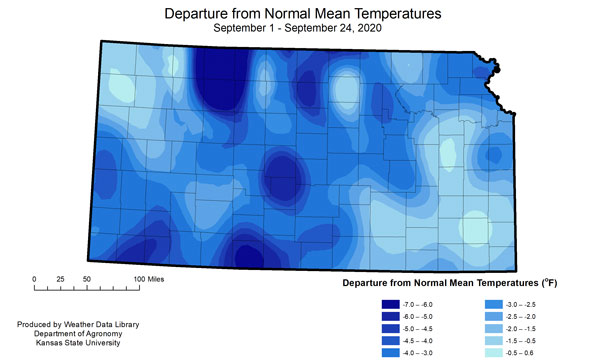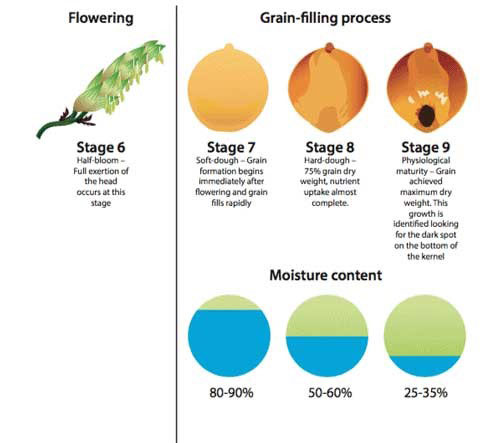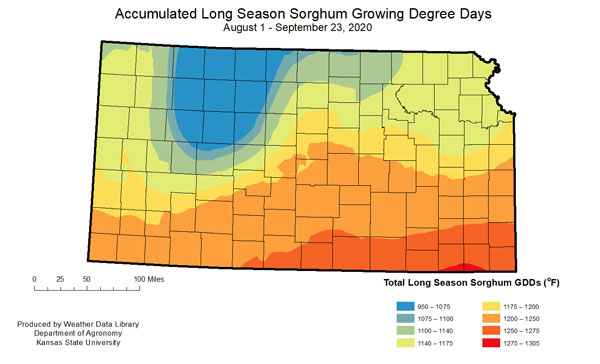The latest USDA-NASS Crop Progress and Condition report for Kansas released September 21 stated that grain sorghum maturity was at 32%, ahead of 18% for last year, and close to the five-year average of 28%. Almost 60% of the crop was rated as good or excellent condition. The extremely cold temperatures of early September likely impacted crop development.
Will the remaining sorghum reach maturity before first freeze? The answer is, it depends. There are two main factors involved:
1) weather conditions and how they affected the development of sorghum during the season, and
2) crop phenology -- when the crop was planted, hybrid maturity, and the date of half-bloom.
Further details on sorghum growth and development can be found at: https://www.bookstore.ksre.ksu.edu/pubs/MF3234.pdf
Weather component
During August, there was a split in the temperature pattern. The south central saw cooler-than-normal temperatures with the greatest departure at 2 to 4 degrees below normal. The warmest conditions were in the western divisions. Departures in the northwest were at 1 to 2 degrees above normal temperatures (Figure 1, upper panel). During September, departures from normal ranged from -7 to +1 degrees. (Figure 1, lower panel).
A delay in flowering time could jeopardize yields if the crop is exposed to heat. Recent K-State research published by Prasad, Djanaguiraman, Perumal, and Ciampitti found that high temperature stress around flowering time (5-days before and after flowering) could impact final grain number.


Figure 1. Departure from monthly mean temperature for the August 2020 (upper map) and September 1 -24, 2020 (lower map). Maps by the Weather Data Library.
Sorghum is also sensitive to cold temperatures during most of its growth period. Temperatures below 40 °F will inhibit sorghum growth. Previous K-State research by Staggenborg and Vanderlip documented the impact on the grain weight early during the grain-filling period when temperatures were below 30 °F. The low temperatures at this time caused lower photosynthetic rates and the inability of the plant to move carbohydrates to the developing grains. From mid-August until this current week (September 24, 2020), the lowest minimums reached 30 °F in a small area of western Kansas.
Grain sorghum life cycle progression
The amount of time between emergence and half-bloom will depend on the planting date and the temperatures during this period. There are also hybrid differences in the amount of time it takes to go from emergence to flowering. Short-season hybrids have a shorter time from emergence to blooming; while full-season hybrids will need more degree days to reach flowering. The overall cumulative GDD from flowering to maturity is about 800-1200 (based on 50 °F as the base temperature), with the shortest requirement in GDD for short-season hybrids. Before maturity, from beginning of grain filling (soft dough until maturity), grain moisture content within a grain will go from 80-90% to 25-35% where black layer is usually formed (Figure 2). From maturity (“black-layer” near the seed base; Figure 3) to harvest time, sorghum grain will dry down from about 35 to 20 percent moisture, but the final maximum dry mass accumulation and final nutrient content will have already been attained at maturity.

Figure 2. Sorghum growth stages from half-bloom and grain filling (including soft dough, hard dough, and physiological maturity). Infographic representing changes in grain coloration and moisture content during grain filling period until black layer formation, maturity. (K-State Research and Extension).

Figure 3. Black-layer identification in sorghum. Photo by Ignacio Ciampitti, K-State Research and Extension.
The likelihood of sorghum maturing before a freeze is related to all of these factors. When the crop flowers in late August or early September, it may not reach maturity before the first fall freeze in some parts of the state.
Probability of sorghum maturing before freeze
The map in Figure 4 show accumulated GDDs up to September 10 for the current growing season, starting at August 1 and September 1. Lower GDDs are depicted with blue colors, while higher GDDs are represented in red colors.
If blooming occurred during mid-August, the likelihood for maturing before freeze is high in most of the areas of the state that have accumulated 1100 GDDs (Figure 4). There are some areas of the state where sorghum GDDs accumulation was below 1100 (primarily related to light blue colors in Figure 4). Those areas will have a slight lower chance of maturing (having accumulated less than 1200 GDDs) before the first freeze. A worse picture is projected for the extreme northwestern area of the state (dark blue colors in Figure 4). In this case, there is a lower probability of maturing before the first freeze (low GDDs, <1000) but it will depend also on the hybrid maturity.

Figure 4. Accumulated Growing Degree Days (expressed in degrees F) for August 1-September 23. The darker the red, the higher the number of accumulated GDDs.
Management considerations
From a management perspective, the best way to mitigate this issue is to plan in advance. Recommended practices are just related to improve the use of different hybrid maturity and a different planting date:
- Use early planting dates for full-season hybrids, or
- When planting later, use medium- to short-season hybrids
If the sorghum is killed by a freeze before maturity, producers should first analyze the crop for the test weight and yield potential before deciding whether to graze or harvest the grain sorghum for silage.
Additonal resources
“Harvesting Grain from Freeze-damaged Sorghum,” K-State publication MF-1081:
http://www.ksre.ksu.edu/bookstore/pubs/mf1081.pdf
“Fall freeze damage in summer grain crops”, K-State publication MF-2234:
https://www.bookstore.ksre.ksu.edu/pubs/MF2234.pdf
Ignacio Ciampitti, Crop Production and Cropping Systems Specialist
ciampitti@ksu.edu
Mary Knapp, Weather Data Library
mknapp@ksu.edu